Purchasing sandbags is relatively simple, right? Maybe not! There are a number of things to consider before you purchase your sandbags, the biggest factor is choosing whether to have them prefilled or empty on arrival.
Whilst this may not sound like it would make much of a difference and doesn’t need to be over analysed, there are factors to consider for both filled and empty sandbags.
Pre filled Sandbags
If you have chosen to buy prefilled sandbags, this will save you time and effort filling them as well as resourcing the sand to fill them. Not only do you avoid the manual filling of the sandbags, but they will be ready to use as soon as they arrive – which is particularly useful if they they are being used as flooding protection.
With all of these positives do come negatives and this may change your mind next time you need to purchase sandbags.
Before you click checkout or pay in person, have you read the small print about the delivery process? There are many companies that which will not deliver to residential premises, usually because of restricted access. If they will deliver to your home, it is vital that you consider the following:
- Where is the delivery address?
- What is the ground like (the surface underfoot)?
- Could a lorry get close enough to your property as well as a forklift?
- Once the sandbags have been delivered, can you move them all to where you need them?
- Have you got enough space to store them?
If you are purchasing pre filled sandbags, you will have the ultimate sandbag ready for immediate use. It will be measured at two-thirds filled which allows for effective stacking of flood defence walls. If you are filling your own, you will need to ensure the sand is the correct type and the sandbags are not over or under filled to ensure they do their job successfully.
Why two-thirds full? This is so the sand inside has room to move around and will allow the sandbag to mould to wherever it is put is put. They are less bulky to move around and less likely to tear due to the pressure.
When your prefilled sandbags are delivered, they will be on a pallet which needs to be put on a hard standing flat surface. They cannot be unloaded onto grass or gravel where they could sink, ruin the standing, or be unable to be moved.
Here at LC Packaging, we accept orders of a minimum of 10 sandbags up to however you require. All are 2/3rds full and you can opt for hessian, UV protected, standard and heavy duty sandbags.

Empty Sandbags
As well as prefilled sandbags, you can also purchase empty sandbags, which come with their own benefits and drawbacks.
Firstly, empty sandbags can almost certainly be delivered to a residential address, should you need them to be sent there. This can make things far easier and reduces the worry of not being able to receive your sandbags when the delivery arrives.
Empty sandbags take less storage space which is beneficial if not immediately required. Whilst it is great to have sandbags in storage for an emergency or whenever you may need them, you may be required to fill them quickly if an emergency arises.
To fill around 12 sandbags can take up to an hour – that’s a fair chunk of time as well as recognising how full the bags are.
Which Ones Do I Purchase?
Whilst sandbags in general are a great thing to purchase, both filled and empty, the question still remains… which ones should I purchase?
This question solely depends on your reasons for purchasing them. For flood defence, we would highly recommend filled sandbags - ready to be put into action as soon as they arrive. Whilst there can be drawbacks to prefilled sandbags such as delivery restrictions and storage, the benefits certainly outweigh them.
Whether you are needing prefilled sandbags or empty sandbags, LC Packaging has everything you need – from Heavy Duty Black UV to Hessian sandbags. These can be delivered next working day or during an emergency, so you are never left short of protection from flooding.
It is important to remember that the Health & Safety Executive recommends that males should not lift any items below shoulder height over 20kg and for women it is 13kg.

